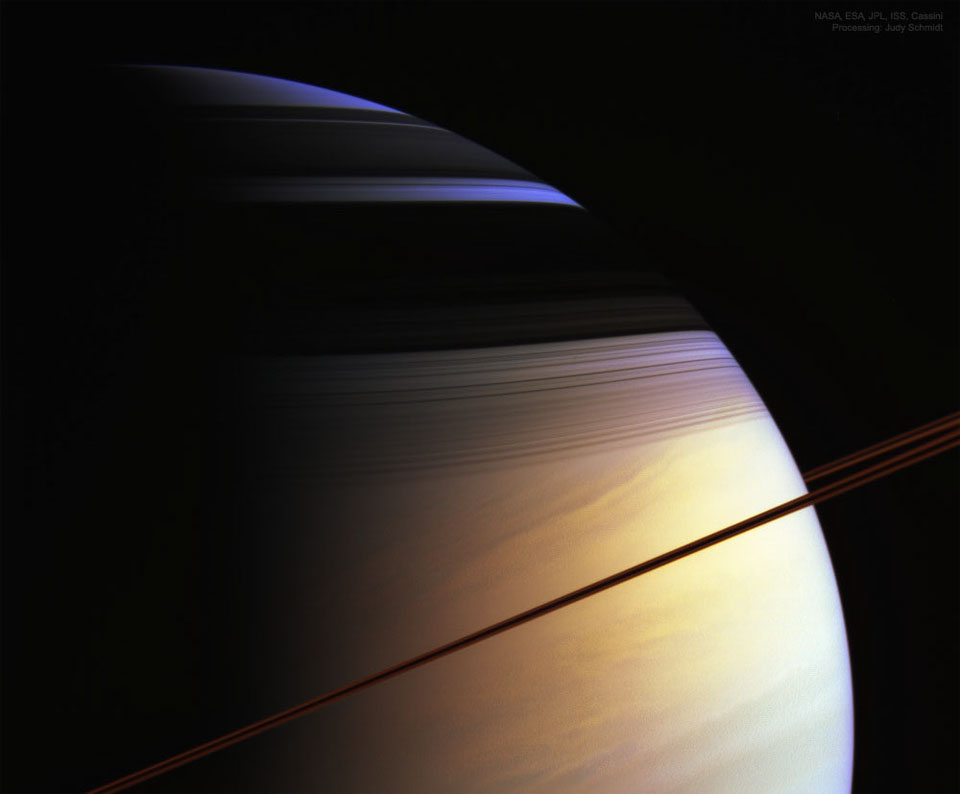Nombre total de pages vues
23/06/2024
SANTé/MEDECINE - Anatomie du coeur humain - Vue gauche du cœur : les structures internes
ASTRONOMY - The Colors of Saturn from Cassini
2024 June 23
Image Credit: NASA, ESA, JPL, ISS, Cassini Imaging Team; Processing & License: Judy Schmidt
Explanation: What creates Saturn's colors? The featured picture of Saturn only slightly exaggerates what a human would see if hovering close to the giant ringed world. The image was taken in 2005 by the robot Cassini spacecraft that orbited Saturn from 2004 to 2017. Here Saturn's majestic rings appear directly only as a curved line, appearing brown, in part from its infrared glow. The rings best show their complex structure in the dark shadows they create across the upper part of the planet. The northern hemisphere of Saturn can appear partly blue for the same reason that Earth's skies can appear blue -- molecules in the cloudless portions of both planet's atmospheres are better at scattering blue light than red. When looking deep into Saturn's clouds, however, the natural gold hue of Saturn's clouds becomes dominant. It is not known why southern Saturn does not show the same blue hue -- one hypothesis holds that clouds are higher there. It is also not known why some of Saturn's clouds are colored gold.
22/06/2024
SANTé/MEDECINE - L'immortalité pour bientôt - Les nanorobots pourraient être la solution
ASTRONOMY - Lynds Dark Nebula 1251
2024 June 22
Image Credit & Copyright: Long Xin
Explanation: Stars are forming in Lynds Dark Nebula (LDN) 1251. About 1,000 light-years away and drifting above the plane of our Milky Way galaxy, LDN 1251 is also less appetizingly known as "The Rotten Fish Nebula." The dusty molecular cloud is part of a complex of dark nebulae mapped toward the Cepheus flare region. Across the spectrum, astronomical explorations of the obscuring interstellar clouds reveal energetic shocks and outflows associated with newborn stars, including the telltale reddish glow from scattered Herbig-Haro objects hiding in the image. Distant background galaxies also lurk in the scene, almost buried behind the dusty expanse. This alluring view spans over four full moons on the sky, or 35 light-years at the estimated distance of LDN 1251.
21/06/2024
SANTé/MEDECINE - L'immortalité pour bientôt - L'immortalité pourrait être proche
SANTé/MEDECINE - Anatomie du coeur humain - Vue du cœur : les valves
ASTRONOMY - Hubble's NGC 1546
2024 June 21
Image Credit: NASA, ESA, STScI, David Thilker (JHU)
Explanation: Returning to science operations on June 14, the Hubble Space Telescope used its new pointing mode to capture this sharp image of spiral galaxy NGC 1546. A member of the Dorado galaxy group, the island universe lies a mere 50 million light-years away. The galactic disk of NGC 1546 is tilted to our line-of-sight, with the yellowish light of the old stars and bluish regions of newly formed stars shining through the galaxy's dust lanes. More distant background galaxies are scattered throughout this Hubble view. Launched in 1990, Hubble has been exploring the cosmos for more than three decades, recently celebrating its 34th anniversary.
20/06/2024
CREATURES DES ABYSSES - Les donzelles
SANTé/MEDECINE - L'immortalité pour bientôt - L'univers peut lui aussi mourir
ASTRONOMY - Sandy and the Moon Halo
2024 June 20
Image Credit & Copyright: Marcella Giulia Pace
Explanation: Last April's Full Moon shines through high clouds near the horizon, casting shadows in this garden-at-night skyscape. Along with canine sentinel Sandy watching the garden gate, the wide-angle snapshot also captured the bright Moon's 22 degree ice halo. But June's bright Full Moon will cast shadows too. This month, the Moon's exact full phase occurs at 01:08 UTC June 22. That's a mere 28 hours or so after today's June solstice (at 20:51 UTC June 20), the moment when the Sun reaches its maximum northern declination. Known to some as a Strawberry Moon, June's Full Moon is at its southernmost declination, and of course will create its own 22 degree halos in hazy night skies.
ASTRONOMY - Christmas Tree Aurora
2024 December 23 Christmas Tree Aurora Image Credit & Copyright: Jingyi Zhang Explanation: It was December and the sky lit up like a ...

-
2021 May 11 Lightning and Orion Beyond Uluru Image Credit & Copyright: Park Liu Explanation: What's happening behind Uluru? A Un...
-
Extraordinary Solar Halos Image Credit & Copyright : Magnus Edback Explanation: Welcome to the December Solstice, the first...









